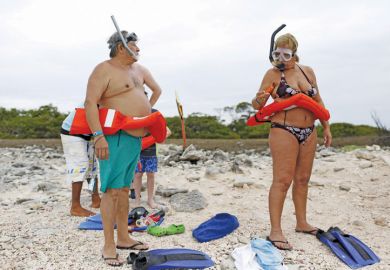Over the past 30 years the study of Atlantic slavery has steadily shifted from the edges of historical curiosity to centre stage. The trend can be gauged by the remarkable and ever-increasing output of scholarship, creative writing and popular cultural representations (novels, films, television and visual imagery) devoted to black slavery. The standard annual bibliography on slave scholarship, for example, runs to a regular 70 pages. More and more graduate students, conferences and institutions are seeking to come to terms with this critical element in the shaping of the Atlantic world.
There are few aspects of slavery which have not attracted the attention of scholars. But as the volume of scholarship increases, it becomes ever more difficult to make sense of slavery in its totality. Here, after all, is an institution which had a transforming effect on three continents (Africa, the Americas and Europe), over a period of four centuries and whose "poisonous legacies" (Robin Blackburn's phrase), have proved corrosive in the modern world.
One of the major contributions of The Making of New World Slavery, Blackburn's impressive new book, is that it makes sense of a rich and varied scholarship to provide a lucid overall account of the development of slavery in its broad Atlantic setting. What is more, he successfully weaves into the narrative his own critical engagement with older debates about nascent western capitalism and state formation. The result is a book which confirms the centrality of Atlantic slavery in the shaping of the modern world. Not only historians of slavery but also historians of early and modern Western Europe need to grasp the degree to which Atlantic slavery was intimately involved in the evolution of `domestic European life.
The broad outline of the story will now be familiar to many general readers. Between Columbus and the final ending of American slavery in the 1880s, something like 11 million Africans were shipped from their homelands to the Americas - the great bulk of them destined for the Caribbean and Brazil (only a small percentage of the total were shipped into North America). And these numbers do not include armies of Africans who died en route to the African coast or on the overland routes north, or across, the Indian Ocean.
The Atlantic slave system involved all the major European maritime nations. It was serviced and financed by the economies of those nations and by their increasingly elaborate and international financial and commercial systems. Some 11,000 slave voyages originated from Britain alone (about half of them from Liverpool), the ships' holds packed with goods from throughout the British hinterland, and with items trans-shipped from the far reaches of Britain's expansive global empire and markets. It was a trade regulated, in one form or another, by metropolitan legislation, and safeguarded and defended by the military forces (themselves waxing and waning) of the various European powers.
The benefits accrued to Europe and to the white settlers of the Americas. Whatever the uncertainties of slave trading - there were losses as well as profits - the lavish wealth of plantocratic fortunes transformed the face of Western Europe, especially Britain. From the Atlantic ports to stately homes, from banking and insurance to the social habits of humble working people (who grew the tobacco and sugar that Europeans consumed in such volumes?), all provide a reminder of the power and importance of Atlantic slavery.
It was not, however, pre-ordained or inevitable. When Europeans made their first tentative and insecure invasions and settlements in the New World, slavery was not a major issue. Indeed, the invading Europeans were leaving behind a continent that was in the process of shedding its own addiction to various forms of bondage. Slavery did not necessarily go hand in hand with pioneering American settlements, though Europeans were not averse to using it where necessary or possible. The Portuguese, in particular, had already begun to use Africans as slaves in the Atlantic islands and in a number of developments within Portugal. And African slaves were indeed among the first foreign invaders of the Americas in the wake of Columbus. But slavery - including the enslavement of Indian peoples - remained peripheral until the arrival of cane sugar and the plantation, firstly in Brazil.
Cane sugar, like the Europeans and the Africans, was alien to the Americas. When this heavily labour-intensive crop took root in the late 16th century, it did so thanks to African slave labour. In the course of the 17th century, the British developed their sweet tooth (along with their insatiable and incurable taste for Virginian tobacco). As European taste for it grew, so too did production: and so too did the importation of African slaves. The success of sugar sealed the fate of millions of Africans. Something like 70 per cent of all Africans shipped across the Atlantic were destined, initially at least, for the sugar fields. But how many Europeans, when sweetening their foods and drinks, even thought of the Africans, in the holds of their pestilential slave ships, or in their debilitated routines of daily toil? Out of sight and generally out of mind, the African slaves and New World descendants laboured mainly for the pleasure and betterment of others on this side of the Atlantic.
From these Iberian origins, the importance of slavery was confirmed by the Dutch in the New World in the late 16th century. They, in their turn, passed their technical knowledge, and the financial aid necessary for new sugar developments in the Caribbean, to the French, and especially to the English. The English settled their Caribbean islands without much thought, at first, of slavery. As early commercial experiments failed, however, and as sugar and the plantations pushed aside other crops and other labour systems, the African again became the critical agent. In the process, slavery acquired the stigmata of race: to be a slave was to be black.
During the 18th century, in the Atlantic struggle between the French and the British to sustain their slave empires, the British emerged victorious. By 1763 the British were the dominant colonial power; and thus they were the dominant slaving and slave-owning power. Though they did not initiate Atlantic slavery, the British perfected it, at sea and in their colonies, to unrivalled levels of economic and social importance.
Since the second world war, historians have been keen to locate the precise role of the slave empire in the rise of British industrial capitalism. Blackburn sensibly moves beyond this old and now somewhat hackneyed argument. Slavery was critical in the development of European state power. Moreover, slavery's commercial ramifications were too intrusive to be teased into simple accounts of profit or loss. Equally, he points out that the slave regimes of the Americas - with their disciplined slave gangs and the harsh routines of sugar factory life - provided a hugely successful test bed for shaping new forms of labour discipline. Experience of the slave fields and the sugar factories was to be influential in the subsequent development of industrial labour in Britain.
Blackburn's book weaves together these complex strands, telling the story, in broadly chronological format, between Columbus and the years of the 18th century when the slave systems were under attack from within (slave resistance) and from without (abolitionism, flowing mainly from Britain). This book ends by overlapping with his earlier volume, The Overthrow of Colonial Slavery. Like that book, the new book's strength lies in its tautness and the direction Blackburn manages to impose on diverse material and layers of arguments that could easily break apart.
It is, as the author admits, a work of synthesis, but it is more than that. In recounting the story of Atlantic slave trading, the development of slavery under the European powers, the indigenous growth of slavery in the Americas and the European impulse behind the whole, it is all too easy to overlook the centre. From first to last, Blackburn remembers (and reminds the reader of) the significance of Europe.
Too often in the writing of the history of this period, historians of Europe have considered Atlantic slavery an interesting sideshow to the main drama unfolding closer to home. Even historians of slavery, by concentrating on the minutiae of slave history, have tended to lose sight of the intimate involvement of Europe. With wide-ranging scholarship and a detailed and persuasive narrative, Blackburn's book confirms the intimate relationship between the history of various European powers and Atlantic slavery. It is, in sum, an important book for anyone interested in the emergence of the modern world. Handsomely produced (and relatively inexpensive for its size), it is needed in paperback.
James Walvin is professor of history,University of York.
The Making of New World Slavery: From the Baroque to the Modern, 1492-1800
Author - Robin Blackburn
ISBN - 1 85984 890 7
Publisher - Verso
Price - £25.00
Pages - 602
Register to continue
Why register?
- Registration is free and only takes a moment
- Once registered, you can read 3 articles a month
- Sign up for our newsletter
Subscribe
Or subscribe for unlimited access to:
- Unlimited access to news, views, insights & reviews
- Digital editions
- Digital access to THE’s university and college rankings analysis
Already registered or a current subscriber?



